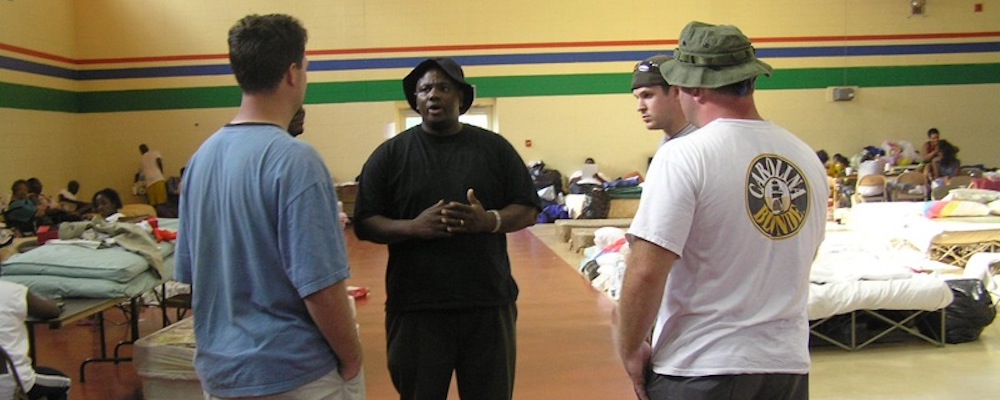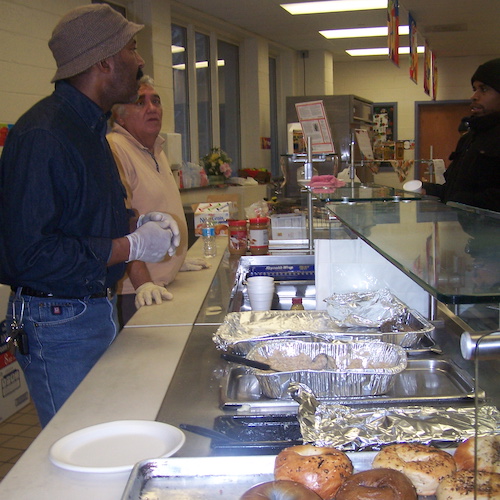 A pastor oversees a shelter for those evacuating from Hurricane Katrina. ©John Whelan, 2005.
A pastor oversees a shelter for those evacuating from Hurricane Katrina. ©John Whelan, 2005.
By Rachel Adams
Implications for Public Health
Investing the time and resources necessary to partner with community- and faith-based organizations can enhance local health department capacity to provide mass care and shelter to disaster-stricken communities.
Before disasters strike, local public health departments are ready to spring into action to prepare shelters for those who need them. They are responsible for assessing the environmental health and safety of shelters, conducting disease surveillance, coordinating the provision of mass care services, and ensuring shelter accessibility. But addressing the public health needs of disaster-afflicted communities can’t be done without support—and that’s where partnering with community groups can be particularly valuable.
Community and faith-based organizations, or CFBOs, play a critical role in disaster preparedness and response. With their insider knowledge of the communities they serve, CFBOs can help local health departments plan for disasters by identifying community needs, communicating messages to the public, and reaching at-risk populations. One of the most important ways CFBOs directly support emergency response efforts is by providing mass care and shelter to disaster-stricken communities.
Federal emergency planning documents, such as the Federal Emergency Management’s Strategic Plan and the Department of Homeland Security's National Response Framework, emphasize the importance of engaging CFBOs in disaster planning. These documents, however, offer limited guidance on what contributes to successful relationships. A team of researchers at UCLA surveyed 273 disaster preparedness coordinators at local health departments in the United States to learn how to strengthen partnerships between government and nongovernmental organizations. Results from this survey suggest that more full-time department staff, positive attitudes towards non-governmental organizations, and inter-organizational trust are associated with engagement between local health departments and CFBOs.
Community Engagement Activities
There are many ways that government agencies can engage community organizations in disaster preparedness and response. These collaborative activities can be grouped into four overarching categories:
Communication and outreach involve the creation, distribution, and promotion of disaster information materials by health departments. Examples can include participating in community education sessions, health fairs, or other events and disseminating emergency preparedness and response communication materials—such as the American Red Cross Shelter Opening Plan , Shelter Rapid Needs Recognition Cards , and Multilingual Shelter Communication Tool —to CFBOs.
Resource sharing occurs when health departments and CFBOs share resources, such as services, facilities, and volunteers, to support disaster preparedness and response. For instance, Voluntary Organizations Active in Disaster (VOADs) is a network of volunteer organizations that participate in preparedness, response, recovery, and mitigation efforts to help disaster survivors and their communities. VOADs can assist health departments in shelter operations by providing disaster case management to evacuees, managing donated goods, and supporting spiritual and emotional care.
Capacity building can occur when health departments work with and train staff at CFBOs so that they can help community members during a disaster. For example, a booklet called Show Me: A Communication Tool for Emergency Shelters was developed by the Massachusetts Department of Public Health Office of Preparedness and Emergency Management as a resource for volunteer organizations and staffers, mental health workers, and public safety personnel to better assist individuals with access and functional needs in an emergency shelter setting. Other examples of capacity building activities include conducting community outreach with CFBO staff, which can help public health organizations better connect with vulnerable and hard-to-reach populations. Ensuring CFBOs have emergency supplies on hand is yet another way to build their capacity.
Partnership planning involves activities that local health departments can engage in to develop and maintain relationships with CFBOs. These include working with CFBOs to create a community-wide disaster preparedness plan with defined roles and responsibilities, establishing formal and informal agreements with partners, developing a National Incident Management System-compliant plan to be used in an emergency with CFBOs, and incorporating mechanisms for these organizations to provide input about emergency preparedness for vulnerable populations. For example, health departments can work with CFBOs to update shelter management plans and manuals so that they include the latest information and guidance.
Facilitating Partnerships
When local health departments have full-time staff dedicated to preparedness, they can better participate in communication and outreach activities with and alongside CFBOs. Unfortunately, limited resources at local health departments make hiring additional staff an ongoing challenge. As such, resource sharing with CFBOs is a more sustainable way to increase staff capacity. Local health departments should therefore work with CFBOs to mobilize volunteers to distribute and promote disaster information materials that can facilitate shelter coordination.
 Volunteers from the nonprofit Angels for Action serve community members displaced by Superstorm Sandy. ©Angels For Action, 2012.
Volunteers from the nonprofit Angels for Action serve community members displaced by Superstorm Sandy. ©Angels For Action, 2012.
CFBO trust in local health departments is associated with greater participation in capacity building and partnership planning. These activities require strong commitment from CFBOs since they must work alongside local health departments to develop emergency response plans, such as those pertaining to shelter operations, and train to become emergency responders in these settings. To build trust, local health departments need to invest time in these relationships and develop mechanisms to address obstacles they may encounter. For instance, establishing a memorandum of understanding that outlines clear roles and responsibilities can help manage expectations needed for effective shelter management. Additional suggestions for activities to strengthen inter-organizational partnerships can be found in the Assessment for Disaster Engagement with Partners Tool .
The knowledge, community connections, and insights of CFBOs can improve public health and emergency management actions during disasters, especially in relation to mass sheltering. Although this does require an investment of time and resources—which are often scarce—the outcome is greater trust, more capacity, and ultimately, a safer and more prepared community.
Suggested Tools
CONVERGE Cultural Competence in Hazards and Disaster Research Training Module
CONVERGE Facility, University of Colorado Boulder
An online training module that focuses on culturally competent research and offers guidance on how hazards and disaster researchers can build cultural competence.
Shelter Opening Plan
American Red Cross
A form that can be used by shelter managers and staff to plan the opening of an emergency shelter.
Shelter Rapid Needs Recognition Cards
American Red Cross
These cards include questions to assist shelter workers in making assessments of clients’ immediate needs at reception and as needed throughout the shelter setting.
Multilingual Shelter Communication Tool
American Red Cross
A manual that helps bridge the gap when shelter residents and workers cannot communicate adequately via a common language.
Show Me: A Communication Tool for Emergency Shelters
Massachusetts Department of Public Health
A booklet to assist individuals with access and functional needs in an emergency shelter setting.
Assessment for Disaster Engagement with Partners Tool
UCLA Center for Public Health and Disasters
An assessment tool that helps local health departments evaluate their partnership activities with community and faith-based organizations and provides recommendations to enhance local collaboration efforts.
For a list of all the tools included in this special collection, visit the Mass Sheltering Tool Index. A list of further readings are also available.
Rachel Adams is a research associate at the Natural Hazards Center and the National Science Foundation-funded CONVERGE initiative. Her research interests include building community resilience, reducing social vulnerability to disasters, and translating evidence-based practices into emergency preparedness and response. She earned her PhD in community health sciences from the University of California Los Angeles Fielding School of Public Health and her Master of Public Health degree in epidemiology and biostatistics from the University of Southern California.